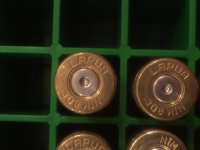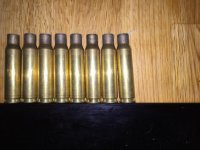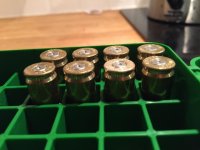Not just the choronograph, but the chronograph
and QuickLOAD. Velocity does not tell you peak pressure. The kinetic energy, which is proportional to the square of velocity, will tell you the
average pressure in the bore when a little basic physics of force and acceleration are invoked. But it does not tell you peak pressure, as the average is of all pressures from start to muzzle. This is why chronograph instruction warn you not to use a chronograph to determine safe loads. That, and the fact many optical chronographs can be off by over 100 fps under some lighting conditions, so they have some liability issues there.
That said, you can cheat. If you have reason to believe your chronograph is behaving well*, you can estimate from published velocity and pressure data and barrel length adjustment allowance what ballpark the peak pressure is in. I put this into Excel awhile back. You basically need data like Hodgdon's or Lyman's that has a start load and start pressure and test barrel length for the kind of bullet you are using. Plug it and your barrel length in, and the Excel file estimates velocity and peak pressure combinations you should get from different powder charges. Tweak the powder charge away from reality until a matching velocity is found, and the peak pressure is probably in the ball park. For better precision, barrel length should be taken as the bullet travel distance. That is, subtract the distance from the cartridge head to the bullet base from rifles or pistols or single-shot handgun barrels. For revolvers first add the cylinder (chamber) length to the barrel length, then subtract that same distance. If the testing was in a SAAMI standard compliant barrel, you can look up the actual lengths of chambers made with vents to mimic a barrel/cylinder gap from the standards at
the SAAMI web site. The test barrels are listed in roughly the last third of each standard.
You can download the Excel file here for the next 30 days or so:
http://www.filedropper.com/pressureandvelocityestimatesfrompublisheddatalockedversion
That version is locked except for the input arguments to prevent accidental alteration of the formulas, but you can see them or do a copy and paste to a blank sheet to have an unlocked copy if you think you know what you are doing.
As usual, you use this sort of thing at your own risk!!!!! Neither the author nor The Firing Line make any guarantee of its accuracy, not do they take any responsibility for the reliability of the results you guet, nor for what you decide you can and cannot do based on those results.
*
A rifle in .22 LR and some good grade match ammunition that you've tested previously over the same chronograph are a good way to check. This is because the huge expansion ratio in a long barrel .22 LR uses up all the powder's energy and the bullet coasts without much velocity change from about 18" to about 26" of barrel length. Match .22 LR ammunition is generally within 50 fps of its manufacturer's claimed velocity from any barrel in that length range.


 )
)


